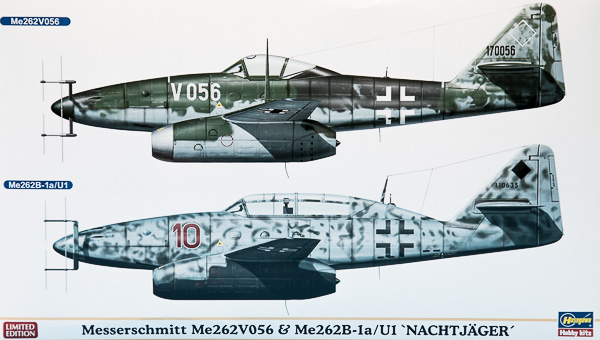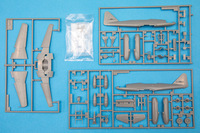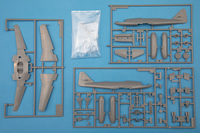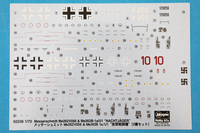
Hasegawa 1/72 Messerschmitt Me 262V056 & Me 262B-1a/U1 'Nachtjäger' Combo
By Chris Banyai-Riepl
Overview
The Messerschmitt Me 262 was the first operational jet fighter, and while it had a very short operational career, there were many variants thrown into the fire. Originally designed as a fighter, it was adopted as a high speed bomber and a night fighter. The latter role is the subject of this dual combo release from Hasegawa, and it covers both single seater and two seater options.
The Kits
Hasegawa's 1/72 Messerschmitt Me 262 kit has been around for a while, and was engineered from the beginning to make multiple variants. As such, most of the plastic is identical between the two kits, with only a few extra bits for the two-seater. As an addition to the original plastic, this boxing also comes with some metal parts for the antenna bits on the single seater, and wire for both kits. As common for a kit of its era, these have recessed panel lines and overall nice surface detailing, with basic interior detailing. The decal options provide two choices for each kit and include a lot of stenciling for both.

|
Starting with the cockpits, these are pretty much the same between the two kits, with the one-piece tub getting separate seats, instrument panels, and control columns. Decals make up the sidewall and instrument panel detailing, and for those who want it, there are pilot figures provided. The two-seater doesn't have a rear control column, and the back instrument panel is attached to the front seat. The completed tub then fits into the fuselage half, along with the separate nose wheel well, and with those in place the fuselage can go together. The two-seater also has some holes to open up in the nose.
The wings are in three pieces, with the one-piece lower wing including the main wheel wells in the fuselage. For the single seater V056, there are also some holes to open up in the wings for the antenna blades that are mounted there. The engines are split into right and left halves, with separate inserts for both the intake and exhaust sections. The wing assembly goes onto the fuselage, the engines on the wings, and with a bit of weight in the nose, the nose cannon insert can go in place. Add the stabilizers and it's just the small details left.

|
Common between both kits is the undercarriage, which has simple struts with separate main wheels. The nose gear strut incorporates the nose wheel as well, which will make painting the wheel a bit more challenging. For the two-seater, you get two fuel tanks to add behind the nose gear. The nose antenna for both kits is the next step, and the instructions provide specific dimensions to cut the metal rods to the right length. For the two-seater, the support arms are provided in plastic, while the single-seater has the support arms in metal. Similarly, the wing antenna blades are metal for the single seater.

|
With all the bits and pieces together, it's time to look at the paint schemes. For the single-seater, you get two color options for V056. The first is standard camouflage, while the second option has the rear fuselage painted and tufted for flow tests. Both have V056 in white on the forward fuselage. For the two-seater, you get the well-known Red 10 from 10./NJG 11 and another plain bird from the same unit. Red 10 was flown by Oberleutenant Kurt Welter and featured a RLM 74/76 squiggle pattern over the upper surfaces and black undersurfaces. The other option has black undersurfaces as well, with the fuselage featuring two shades of green over the RLM 76 base and the wing/tailplane uppersurfaces in RLM 82 green. The decals, as noted earlier, feature a lot of extra stenciling, which will add to the realism of the finished models.
Conclusion
While there are newer and better detailed 1/72 Me 262 kits out there, the Hasegawa kit still builds up into a good looking representation of this famous fighter. For those wanting to go all out, there are also lots of aftermarket sets for it as well. As a straight out of box build, though, it will make for a fast project, even with all the extra metal bits for the antenna. Whichever way you go, you'll have some interesting Me 262 variants on your shelf. My thanks to Hasegawa USA for the review sample.
